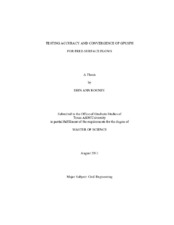| dc.description.abstract | The effect of vegetation on the dissipation of waves is important in understanding the vegetation's role in protecting coastal communities during extreme events such as hurricanes and tsunamis. Numerical modeling makes it possible to study the flow through vegetation fields, but it is important to understand the flow dynamics around one piece of vegetation and validate the numerical model used, before the dynamics of an entire vegetated patch can be modeled and understood. This project validated GPUSPH, a Lagrangian mesh-free numerical model, by determining the optimal characteristics to obtain accurate simulations for flow through a flume with and
without an obstruction.
The validation of GPUSPH and determination of optimal characteristics was accomplished by varying model particle spacing, sub-particle scale (SPS) turbulence inclusion in the conservation of momentum equation, and kernel weighting function for two test cases. The model particle spacing sets the initial distance between the moving grid points, known as particles, in the system. The SPS turbulence term is intended to account for turbulence generated at the sub-particle scale between the particles. The kernel weighting functions used are the quadratic kernel and the cubic spline kernel. These kernels determine how much influence surrounding particles have on the flow characteristics of an individual particle.
The numerical results of these tests were compared with experimental results to obtain conclusions about the accuracy of these simulations. Based on comparisons with experimental velocities and forces, the optimal particle spacing was found to occur when the number of particles was in the high 100,000s for single precision calculations, or mid-range capabilities, for the hardware used in this project. The sub-particle scale turbulence term was only necessary when there was large-scale turbulence in the system and created less accurate results when there was no large-scale turbulence present. There was no definitive conclusion regarding the best kernel weighting function because neither kernel had overall more accurate results than the other. Based on these conclusions, GPUSPH was shown to be a viable option for modeling free-surface flows for certain conditions concerning the particle spacing and the inclusion of the subparticle scale turbulence term. | en |


